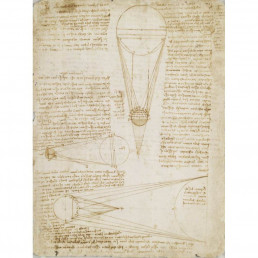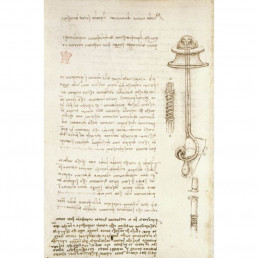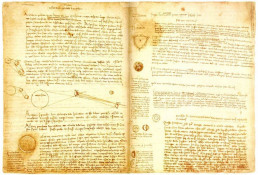11-Aug-2019
A museum exhibition dating back half of a millennium may not immediately seem like an organic fit in a cutting-edge finance and technology blog. However, this isn’t just any exhibition we’re talking about – this is a Leonardo da Vinci exhibition at the British Library. The quality and quantity of scientific and academic content of the works on display were orders of magnitude greater than any technology discussed throughout the rest of my blog.
With 3 codices for the first time on display together, the exhibition makes for a riveting experience (and also a chilling one – the exhibition room is kept at 17 Centigrade in order to preserve the manuscripts). Each and every one of the pages on display (“codex” is really just a fancy term for “notebook”) presents an insight or thought that would make worthy life’s work for most non-genius folk.
Facing Leonardo’s work is an experience comparable to seeing “2001: a space odyssey” for the first time – it’s not exactly religious, not really spiritual (I don’t like this word anyway), but transcendental still. There is, of course, a huge degree of subjectivity (my mom was not exactly riveted by “2001:…”), but facing this calibre of genius up close was deeply moving. Right before my eyes, separated from me only with a thin sheet of glass, were the notes of one of the finest polymathic minds in the history of mankind.
The exhibition showcases 3 of Leonardo’s codices (out of a total of 11 his works were broken into):
- Codex Arundel: 283 sheets of notes on various subjects, including mechanics and geometry (from British Library’s own collection)
- Codex Forster: notes on a variety of scientific topics including hydraulics, weights, and geometry (from the V&A Museum in London)
- Codex Leicester: 36 sheets on a variety of topics including astronomy, geology, and the flow of water (one of the topics Leonardo seemed to have a particular fascination with). Codex Leicester is a property of Bill Gates, who purchased it in 1994 for USD 30.8 mln* (so close to a million per sheet) and allows it to be exhibited worldwide.
Leonardo’s famous mirror writing just adds to his mystique – what made him write this way? Is it just because he was left-handed? (seems a bit contrived an explanation). Fun fact: the multiplication table (up to 10×10) on one of the sheets is written left-to-right.
Even on a purely aesthetic level, Leonardo’s work is a delight. The beige sheets – almost all of them richly illustrated – have artistic values. The drawings may not all be quite Salvator Mundi-quality, but they are spectacular nonetheless. Even the handwriting itself is stylish; I mean, just look:



The realisation that Leonardo made these notes and drawings himself was pretty mindblowing in its own right. It’s almost like Leonardo was there himself.
The stylish-to-a-fault exhibition** doesn’t even present the complete contents of the 3 codices – just selected sheets, and many of these sheets contain enough to be an accomplished Renaissance academic’s life’s work. So that’s just a fraction of his scientific work, all of which is on top of 2*** of the world’s most famous paintings: the Mona Lisa and the Last Supper. To me that realisation – coming up close with it – was the most moving and transfixing experience of the entire exhibition: how did he do it? Was Leonardo just some sort of statistical inevitability (out of large enough population a supergenius polymath of his calibre simply *had to* emerge)? What did it feel like to be him? Was famously private Leonardo aware of the extent of his own genius and talent?
All these questions (and many more) were tackled by Oxford University’s Professor Martin Kemp during an accompanying event on Tue 06-Aug-2019. In an interdisciplinary talk (which lasted well over an hour but felt like a moment) he showed the audiences how to find beauty in Leonardo’s scientific work and how to find scientific accuracy in Leonardo’s art.
Prof. Kemp said that Leonardo exhibited “almost pathological attention to detail” – something I’m a big fan of myself. He also mentioned that everything Leonardo ever did (though I’m unsure whether that included paintings) was an act of analysis – “how does the mechanism work?” was apparently one of the questions driving Leonardo throughout his life and work. Professor Kemp added that Leonardo admired the perfection of the structure of things and believed that a great design had an element of inevitability; consequently, Leonardo was much more of a geometric rather than an arithmetic mind. He set himself impossible, “unfinishable” tasks (something I can relate to), was famously private (something I can’t relate to at all), but he did apparently like dirty humour (something I can relate to).
Prof. Kemp mentioned that for Leonardo science and fantasy went hand in hand. It wasn’t perhaps entirely uncommon at the time (though it would more likely have been science and religion and/or theology), but still, it seems just so naturally and organically fitting to his work, where groundbreaking science and art worked hand-in-hand.
Fun fact: Prof. Kemp is of a certain age (77 years young to be exact), yet when he was on stage discussing Leonardo, he was literally beaming with the enthusiasm and energy of someone much younger. It was quite incredible. I hope that I will one day find that one thing that will give me as much joy and fulfilment.
* Normally, I’m rather unimpressed with 8- or 9-figure sums paid for works of art (it’s pure excess to me), but I have to say, for Leonardo’s codex I’m willing to make an exception: that was money well spent.
** Fittingly, the exhibition is sponsored and styled by Pininfarina, the Italian automotive design house behind some of the world’s most stylish sports cars.
***3 If we count Salvator Mundi.
